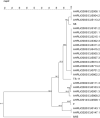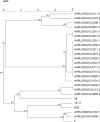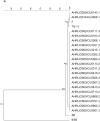Targeted sequencing analysis of Mycoplasma gallisepticum isolates in chicken layer and breeder flocks in Thailand
- PMID: 35701517
- PMCID: PMC9198072
- DOI: 10.1038/s41598-022-14066-4
Targeted sequencing analysis of Mycoplasma gallisepticum isolates in chicken layer and breeder flocks in Thailand
Abstract
Mycoplasma gallisepticum (MG) is one of the most economically important pathogens worldwide. MG affects the respiratory system and impairs growth performance in poultry. In developing countries, the most widely used technique to identify MG is the conventional PCR assay. In this study, 24 MG isolates collected from Thailand farms with unvaccinated chickens during 2002-2020 were characterized by gene-targeted sequencing (GTS), followed by phylogenetic analysis using unweighted pair group method with arithmetic mean. These 24 Thai MG isolates differed from vaccine strains, including the F, ts-11 and 6/85 strains. One isolate showed 99.5-100% genetic similarity to the F strain with 4 partial gene analyses. This result may have been due to contamination from vaccinated flocks because the F strain is the most commonly used vaccine strain in Thailand. However, the GTS analysis using the partial MG genes in this study showed that the isolates could be grouped into different patterns based on individual gene sequences. The phylogenetic analysis of partial mgc2, gapA, pvpA and lp gene sequences classified the Thai MG isolates into 7, 11, 7 and 2 groups, respectively. In conclusion, at least 2 partial MG genes, especially partial gapA and mgc2 genes, are needed to differentiate MG isolates.
© 2022. The Author(s).
Conflict of interest statement
The authors declare no competing interests.
Figures




Similar articles
-
Complete Sequence-Based Genotyping of mgc2/pvpA Genes in Chicken-Derived Mycoplasma gallisepticum Isolates of Iran.Avian Dis. 2020 Dec 1;64(4):507-516. doi: 10.1637/aviandiseases-D20-00032. Avian Dis. 2020. PMID: 33570101
-
Molecular characterization of Mycoplasma gallisepticum isolates from Jordan.Avian Dis. 2011 Jun;55(2):212-6. doi: 10.1637/9526-091510-Reg.1. Avian Dis. 2011. PMID: 21793435
-
Identification of Strain-Specific Sequences That Distinguish a Mycoplasma gallisepticum Vaccine Strain from Field Isolates.J Clin Microbiol. 2016 Dec 28;55(1):244-252. doi: 10.1128/JCM.00833-16. Print 2017 Jan. J Clin Microbiol. 2016. PMID: 27847370 Free PMC article.
-
Control of avian mycoplasmoses by vaccination.Rev Sci Tech. 1996 Dec;15(4):1527-53. doi: 10.20506/rst.15.4.985. Rev Sci Tech. 1996. PMID: 9190024 Review.
-
Clinical expression, epidemiology, and monitoring of Mycoplasma gallisepticum and Mycoplasma synoviae: an update.Avian Pathol. 2022 Feb;51(1):2-18. doi: 10.1080/03079457.2021.1944605. Epub 2021 Sep 21. Avian Pathol. 2022. PMID: 34142880 Review.
Cited by
-
Mycoplasmosis in Poultry: An Evaluation of Diagnostic Schemes and Molecular Analysis of Egyptian Mycoplasma gallisepticum Strains.Pathogens. 2023 Sep 5;12(9):1131. doi: 10.3390/pathogens12091131. Pathogens. 2023. PMID: 37764939 Free PMC article.
-
Robust and highly efficient transformation method for a minimal mycoplasma cell.J Bacteriol. 2025 Mar 20;207(3):e0041524. doi: 10.1128/jb.00415-24. Epub 2025 Feb 4. J Bacteriol. 2025. PMID: 39903184 Free PMC article.
-
A Multiplex PCR Assay for Differential Identification of Wild-type and Vaccine Strains of Mycoplasma gallisepticum.Pathogens. 2023 Jan 9;12(1):111. doi: 10.3390/pathogens12010111. Pathogens. 2023. PMID: 36678459 Free PMC article.
-
Epidemiological and molecular characterization of investigation of Mycoplasma gallisepticum of goose origin in Guangdong (China).Poult Sci. 2025 Feb;104(2):104791. doi: 10.1016/j.psj.2025.104791. Epub 2025 Jan 8. Poult Sci. 2025. PMID: 39827697 Free PMC article.
-
Infection, Transmission, Pathogenesis and Vaccine Development against Mycoplasma gallisepticum.Vaccines (Basel). 2023 Feb 17;11(2):469. doi: 10.3390/vaccines11020469. Vaccines (Basel). 2023. PMID: 36851345 Free PMC article. Review.
References
-
- Armour, N. K. in Diseases of poultry (ed Swayne D. E. et al.) 911–923 (Wiley-Blackwell, 2020).
-
- Pakpinyo, S. in Important mycoplasmosis in Thailand (โรคติดเชื้อมัยโคพลาสมาที่สำคัญของสัตว์ปีก) (ed Pakpinyo S.) 1–11 (WorkDee Idea, 2017).
Publication types
MeSH terms
Substances
LinkOut - more resources
Full Text Sources
Medical

